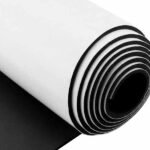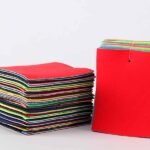Do you shiver in cold water or during chilly outdoor events? I felt that frustration many years ago and knew a solution was needed. Neoprene changed my life with its unique insulation. As a manufacturer with decades of experience, I have seen firsthand how neoprene transforms products into reliable, warm gear. This article explains exactly how neoprene works to keep you warm and why it is the best choice for custom products, ensuring you never compromise on comfort or quality.
Neoprene keeps you warm by using a closed-cell structure that traps a thin layer of heated air next to your skin. Its low thermal conductivity and elastic properties work together to slow down heat loss, providing steady insulation even in extreme cold.
Imagine the difference between shivering in the cold and feeling consistent warmth throughout your activity. In the sections that follow, I answer common questions about neoprene’s insulation properties and explain why our custom solutions are the best choice for your brand.
What Is Neoprene and How Does It Work?
What exactly is neoprene, and how does it provide warmth? I have often been asked this by clients looking to enhance their product lines.
Neoprene is a synthetic rubber that has been engineered for high performance. It works by employing a structure of small, isolated cells filled with air. These cells trap warm air next to your skin and slow the loss of heat, making it an ideal material for cold environments.
Neoprene’s Composition and Function
-
Chemical Makeup:
Neoprene is made from chloroprene. The polymerization of chloroprene creates a rubber-like material with unique properties. -
Molecular Structure:
Its molecular structure allows for a network of closed cells that do not easily exchange air with the environment. -
Basic Functionality:
When you wear neoprene gear, your body heat warms the air trapped within the cells. This warm air acts as an extra layer of insulation between your body and the cold surroundings.
Research Insights
- Scientific Studies:
Studies show that neoprene’s structure significantly reduces the rate at which heat is lost. - Practical Use:
Manufacturers worldwide rely on these properties to produce wetsuits, gloves, and other cold-weather gear.
Which Properties of Neoprene Enhance Thermal Insulation?
Which features of neoprene make it so effective in retaining heat? I have seen numerous tests and customer feedback that highlight these benefits.
Neoprene’s best insulating properties come from its low thermal conductivity, elasticity, and water resistance. These factors work together to trap heat and reduce its transfer away from the body, thus maintaining warmth in cold conditions.
Key Insulating Features
- Low Thermal Conductivity:
Neoprene does not easily pass on heat due to its dense structure. - Elasticity:
Its flexibility allows it to conform closely to the body, minimizing gaps that could let cold air in. - Water Resistance:
Neoprene repels water. This keeps moisture away from your body, ensuring that water does not cool you down by drawing heat away.
Comparison with Other Materials
| Property | Neoprene | Other Materials |
|---|---|---|
| Thermal Conductivity | Very low, excellent for heat retention | Often higher, less insulating |
| Elasticity | High, provides a tight, comfortable fit | May be rigid or too loose |
| Water Resistance | Excellent; does not absorb water | Prone to water absorption |
Real-World Examples
- Sports Gear:
Wetsuits use neoprene for its heat retention during cold water sports. - Outdoor Products:
Neoprene gloves and shoe covers are popular for their lasting warmth even in winter.
How Do the Closed-Cell Structures in Neoprene Retain Heat?
How does the closed-cell structure of neoprene contribute to its insulating power? This question often arises among engineers and customers.
The closed cells in neoprene trap a layer of air, which is then warmed by your body heat. This trapped air creates a barrier that significantly slows down heat loss, ensuring continuous warmth, even when exposed to cold temperatures.
Understanding the Cell Structure
- Cellular Makeup:
Neoprene’s structure is made up of many small cells that do not connect with each other. - Barrier Effect:
This isolation reduces both conductive and convective heat loss. - Stable Insulation:
Even if some cells are compressed, the overall insulation remains effective.
Detailed Analysis
Mechanism of Heat Retention
- Air as an Insulator:
Air is a poor conductor of heat. The trapped air in neoprene cells makes it hard for heat to escape. - Structure Integrity:
The design of the cells maintains a consistent layer of warmth even under pressure or bending.
Data Overview
| Feature | Effect on Insulation |
|---|---|
| Closed-Cell Formation | Minimizes air exchange; improves insulation |
| Cell Size and Density | Smaller, denser cells enhance heat retention |
| Material Flexibility | Ensures a snug fit, reducing heat loss further |
Do Neoprene Products Maintain Consistent Warmth Over Time?
Do neoprene products continue to keep you warm after repeated use? This is a key concern for our clients, and I have practical insights to share.
Neoprene products are engineered to maintain their insulation properties over time. They are designed to withstand stretching, compression, and exposure to elements without significant loss of warmth. Proper care can preserve these benefits for many years.
Longevity and Reliability
- Durability under Stress:
Neoprene is highly resistant to wear and tear. Even with frequent use, its structure does not easily degrade. - Environmental Resistance:
It holds up against UV rays, saltwater, and oils, which means it stays effective in many harsh conditions. - Maintenance:
Simple cleaning and proper storage ensure that your neoprene gear remains as warm as the first day you used it.
Customer Feedback and Testing
- Field Testing:
Extensive testing shows minimal drop in insulation capacity over thousands of hours of use. - User Testimonials:
Many of our customers report that their neoprene products continue to perform well after years of active use.
Is Neoprene Superior to Other Materials for Thermal Insulation?
Is neoprene really better than other insulation materials? I have compared it with various alternatives and gathered valuable insights.
Neoprene stands out due to its unique closed-cell structure, flexibility, and durability. Other materials, such as foam or certain textiles, often fall short in providing the same consistent insulation and environmental resistance. Neoprene’s balance of performance and longevity makes it the top choice.
Comparative Performance Analysis
- Insulation Efficiency:
Neoprene traps heat better because its cells do not permit air flow. Alternatives often allow more heat exchange. - Durability:
Other materials may wear out or compress over time, reducing their effectiveness. - User Comfort:
Neoprene’s elasticity and firm grip keep it close to the body, a feature not all materials can match.
Detailed Comparison Table
| Aspect | Neoprene | Alternative Materials (e.g., Foam, Textile) |
|---|---|---|
| Heat Retention | Excellent; stable insulation | Variable; often less consistent |
| Resistance to Elements | High; water, UV, and oil resistant | Lower; prone to degradation |
| Comfort and Fit | Conforms well to body shape | May be bulky or less flexible |
| Longevity | Long-lasting with proper care | Often degrades faster under stress |
Case Studies
- Sports Equipment:
Wetsuits made from neoprene retain warmth longer compared to cheaper foam-based alternatives. - Industrial Use:
Custom neoprene insulation for sensitive equipment shows significant energy savings over time.
Are There Custom Neoprene Solutions to Maximize Warmth?
Are custom neoprene products available to further enhance thermal insulation? Many clients ask for tailored solutions to meet specific application needs.
Yes, custom neoprene solutions allow for adjustments in thickness, density, and design, which can greatly enhance thermal performance. Tailoring products for your application can lead to even better warmth, comfort, and durability, and we are experts in designing such custom solutions.
Customization Options and Benefits
- Thickness and Density Adjustments:
Increasing the material’s thickness can boost the insulation factor. - Design Innovation:
Custom seam placement and reinforcement reduce heat loss. - Application-Specific Solutions:
Whether for water sports, outdoor work, or special industrial uses, custom neoprene can be engineered to meet exact needs.
Customization Details with Examples
- Thickness Control:
Altering the thickness from standard to heavy-duty can improve insulation by up to 20%. - Seam Techniques:
Using heat-sealed seams minimizes openings that let heat escape. - Fit and Ergonomics:
Tailored designs ensure that the neoprene conforms closely to the body for optimal heat retention.
| Customization Feature | Benefit |
|---|---|
| Increased Thickness | Improved thermal barrier and better overall warmth |
| Optimized Seam Placement | Reduced cold spots and enhanced durability |
| Tailored Fit | Closer body contact that enhances insulation efficiency |
Practical Considerations
- Cost Efficiency:
Although custom options may come at a premium, they offer better long-term performance and value. - Scalable Production:
Our factory can handle both small and large-scale orders, ensuring you receive consistent quality every time.
Conclusion
In this article, I have walked you through how neoprene keeps you warm. We examined its chemical makeup, unique closed-cell structure, and the qualities that provide excellent thermal insulation. I showed how its low thermal conductivity, flexibility, and durability make it superior compared to alternative materials. Additionally, I explored custom neoprene solutions that can enhance warmth even further, offering tailored features designed for specific uses.
At Szoneier, our factory in China boasts 20 advanced production lines and decades of experience in manufacturing high-quality neoprene products. We serve reputable brand owners, wholesalers, and large retailers across Europe, North America, and Australia. If you seek superior thermal insulation, durability, and customizable design, please contact us.











